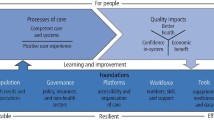Abstract
Data sources
Medline, Embase, CINAHL, LILACS, Cochrane Database of Systematic Reviews, OpenGrey (System for Information on Grey Literature in Europe [SIGLE]-based), Scirus, Science.gov, Cost-Effective Analysis (CEA) Registry, European Network of Health Economics Evaluation Databases (EURON-HEED), ClinicalTrials.gov and Health Services Research Projects in Progress (HSRProj) databases. They also contacted 20 separate organisations.
Study selection
All study designs were considered with no limits on dates, age of study, language or country. Government reports, peer-reviewed publications, dissertations and theses were included. Editorials, opinion pieces, educational pieces, narrative reviews, abstracts without full-text availability and raw data such as those from national oral health surveys were excluded. Study quality and risk of bias was assessed.
Data extraction and synthesis
Data extraction was conducted independently, and meta-analysis was planned for the data, but only a qualitative synthesis could be conducted.
Results
Eighteen observational studies were included, 13 were considered to be at high risk of bias, five at moderate risk and one at low risk. They were conducted in Australia, Canada, Hong Kong, New Zealand and the United States. All the studies were related to dental caries with only studies involving dental nurses and therapists meeting the inclusion criteria. No studies regarding cost effectiveness, irreversible diagnostic procedures or diseases other than caries were in included.
Conclusions
The authors concluded that the quality of the evidence was poor. They found that in select groups in which participants received irreversible dental treatment from teams that included midlevel providers, caries increment, caries severity or both decreased across time; however, there was no difference in caries increment, caries severity or both compared with those in populations in which dentists provided all irreversible treatment. In select groups in which participants had received irreversible dental treatment from teams that included midlevel providers, there was a decrease in untreated caries across time and a decrease in untreated caries compared with that in populations in which dentists provided all treatment.
Similar content being viewed by others
Log in or create a free account to read this content
Gain free access to this article, as well as selected content from this journal and more on nature.com
or
References
Galloway J, Gorham J, Lambert M, et al. The professionals complementary to dentistry: systematic review and synthesis. University College London, Eastman Dental Hospital, Dental Team Studies Unit, 2002.
Sibbald B, McBride A, Birch S . Labour substitution and efficiency in health care delivery: general principles and key messages. Centre for Workforce intelligence. London 2011. http://www.cfwi.org.uk/publications/labour-substitution-and-efficiency-in-healthcare-delivery-general-principles-and-key-messages [Accessed March 2013].
Dyer T, Brocklehurst P, Glenny AM, et al. Dental auxiliaries for dental care (Protocol). Cochrane Database Syst Rev 2012; Issue 9. Art. No. CD010076. DOI: 10.1002/14651858.CD010076.
Author information
Authors and Affiliations
Additional information
Address for correspondence: Dr. Frantsve-Hawley, Research Institute and Center for Evidence-Based Dentistry, Division of Science, American Dental Association, 211 E. Chicago Ave., Chicago, Ill. 60611, USA. E-mail: frantsvej@ada.org
Wright JT, Graham F, Hayes C, et al. A systematic review of oral health outcomes produced by dental teams incorporating midlevel providers. J Am Dent Assoc 2013; 144: 75–91.
Rights and permissions
About this article
Cite this article
Richards, D. Only limited evidence available for the effectiveness and cost effectiveness of dental auxiliaries. Evid Based Dent 14, 38–39 (2013). https://doi.org/10.1038/sj.ebd.6400927
Published:
Issue date:
DOI: https://doi.org/10.1038/sj.ebd.6400927



